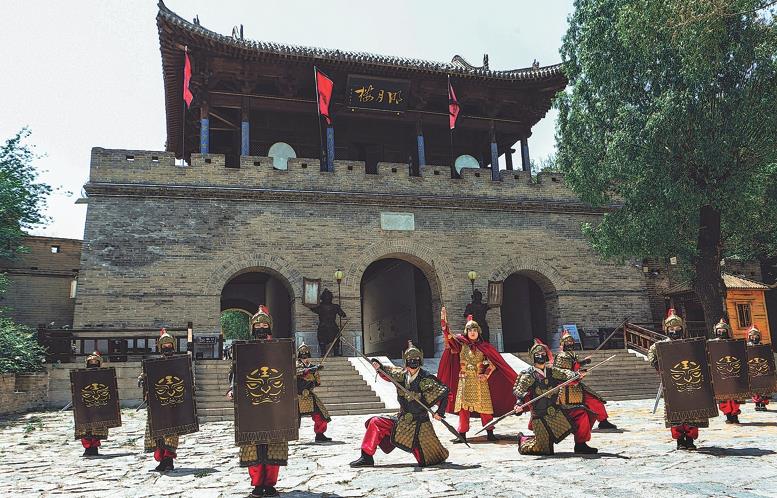
A live show is performed in front of Yanmen Pass to entertain tourists.
The famed Yanmen Pass, a witness to history at the ancient frontier of northern Shanxi, is now seen by local officials and industry insiders as a precious asset to attract tourists.
Vice-Governor of Shanxi Zhang Fuming and other tourism officials and experts went on a research trip to the site. They said the development of Yanmen Pass is an epitome of the province's new tourism marketing campaign that focuses on local cultural and historical legacies.
During a meeting with local officials and industry insiders, Zhang encouraged the county to be a role model for cultural tourism in Shanxi by making use of local historical assets.
"We expect Yanmen to become a favored destination among tourists by integrating its cultural and natural resources, exploring the depth of local history and improving services and infrastructure," Zhang said.
Zhao Xinping, a history professor at the local Xinzhou Normal College, said the unique selling point of Yanmen is that it is closely related to the history of China.
Located in Daixian county of Xinzhou city, Yanmen is an important pass through the inner line of the Great Wall.
Situated at a place of strategic importance that was difficult to get through, it was regarded as "the most important among the nine passes under heaven" in ancient times, Zhao said.
According to Zhao, more than 1,700 battles have taken place in the area over more than 2,000 years, including some decisive wars that shaped the nation.
"As an old saying goes, 'the nation would be safe if Yanmen was under control and the nation would be endangered if it lost control of the pass.' It shows the strategic importance of the site in history," Zhao said.
In the Warring States Period (475-221 BC), the original pass was built on the summit of a mountain accessible only by an ancient trail in defense against the northern nomads. During the Yuan Dynasty (1271-1368) it fell into disrepair. The current Yanmen Pass was rebuilt in 1374 during the Ming Dynasty (1368-1644).
Yanmen Pass is about 1 kilometer long and the height of the wall is about 4 meters. There are three gates in Yanmen Pass, with the central gate called Yanmen built over a tiny pass between two hills. Yanmen means "wild goose gate" in Chinese, and is named so because wild geese are seen flying around the pass every year. The western gate is called Dili which means "to choose the proper location for a battle" and the eastern gate is called Tianxian, which means "an impregnable fortress".
The entire scenic area of Yanmen covers 130 square kilometers, including the Great Wall, the pass, watchtowers and fortresses.
By YUAN SHENGGAO
Li Yali contributed to this story.
 山西路桥:党建引领 建好“四好农村路”山西路桥建设集团党委扎实开展“党建质量提升年”,实施“六大工程”,立足“十四五”高质量、高速度、高效益发展的战略基点,全面提高党建质量和党建引领发展水平,为打造“国内一流的交通基础设施投资、建设、施工现代化企业集团”提供坚强政治保障。
山西路桥:党建引领 建好“四好农村路”山西路桥建设集团党委扎实开展“党建质量提升年”,实施“六大工程”,立足“十四五”高质量、高速度、高效益发展的战略基点,全面提高党建质量和党建引领发展水平,为打造“国内一流的交通基础设施投资、建设、施工现代化企业集团”提供坚强政治保障。
 常住人口3491万 山西人口普查数据"出炉"山西省统计局向社会通报山西省第七次全国人口普查主要数据。数据显示,山西省常住人口为34915616人,比2010年(第六次全国人口普查数据,下同)减少2.23%,年平均减少0.23%。山西省常住人口总量减少,主要受人口流动变化等因素影响。
常住人口3491万 山西人口普查数据"出炉"山西省统计局向社会通报山西省第七次全国人口普查主要数据。数据显示,山西省常住人口为34915616人,比2010年(第六次全国人口普查数据,下同)减少2.23%,年平均减少0.23%。山西省常住人口总量减少,主要受人口流动变化等因素影响。